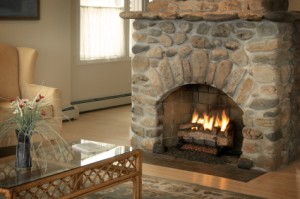Masonry fireplaces are built of brick or stone and mortar, while pre-fabricated fireplaces include a metal chimney and firebox. There are advantages and disadvantages to both, with safety and cost foremost in the minds of most homeowners. In a nutshell, both are safe when maintained properly and, while pre-fabricated fireplaces are less expensive to install, brick fireplaces are more durable.

The materials and labor costs of a custom-built masonry fireplace are considerable, making it the more expensive option. However, not only will it be custom-designed to fit and suit your house but, with proper care, it will last a lifetime. Built entirely from brick, a masonry fireplace can also handle hotter fires than a pre-fabricated one.
Often made from lightweight inferior metals, pre-fabricated fireplaces can warp if repeatedly exposed to intense fires. Furthermore, although they call for “zero clearance”, an air space around the chimney is invariably required. They are designed and described as “decorative heating appliances” and are not intended to withstand hot fires.
That said, pre-fabricated fireplaces are a far more affordable option and can be of very good quality. Continuous stainless steel flue liners are now available, and because components are designed to function together, pre-fabricated fireplaces are highly efficient. Often easier to clean than brick chimneys, metal flues are actually less likely to see a dangerous buildup of creosotes and safer in that way.
Regardless of which type of fireplace you go with, wood should not be stacked too near the chimney. A process called pyrolisis lowers the ignition point of wood from more than 400 degrees to 250, allowing it to catch fire merely with the heat transferred from the fireplace. Burning fires of controlled size and not feeding them too much fuel will keep their temperatures within a good range and enhance their safe usage.
Give us a call if you’d like a personal consultation for your particular situation.
